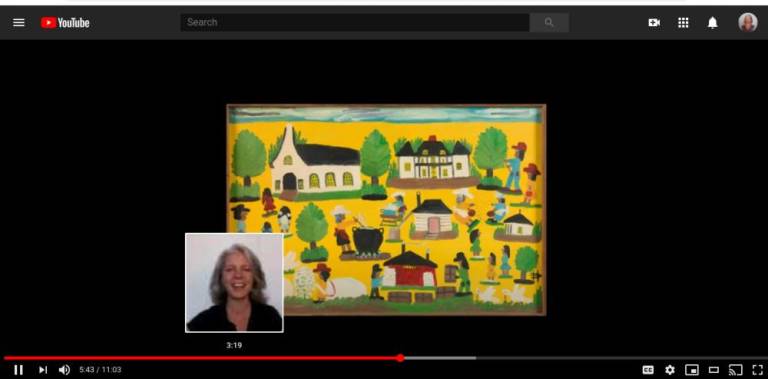At 305 West End Residence and various other senior care facilities in the city, where visitors have been prohibited due to the pandemic, the residents have continued to engage in the enrichment of an art museum.
The American Folk-Art Museum on the Upper West Side hosts the Folk-Art Reflections series, which is designed for seniors with Alzheimer’s or other forms of cognitive impairment. Since museums and recreational programs for seniors were closed at the start of quarantine, Elizabeth Gronke, the access educator for AFAM, has taken the program to Zoom.
In each Zoom session, which is also available on YouTube, Gronke walks through different pieces of art with the viewers, speaking slowly and giving generous pauses for the audience members to digest the information and ask questions.
“It’s not like what you think of when you go to a museum and you have a guided tour, where the they’re just sort of spouting off facts about the artist,” Gronke said. “In our program, the facts and the information, the background information about the art, comes up only if it’s relevant or resonant with something that someone’s noticing.”
For seniors in nursing homes, the pandemic has made what is already a difficult situation even more isolating. Gronke points out that because Alzheimer’s patients struggle with their sense of time, the lockdown and lack of visitors — or even visitors via Zoom or FaceTime — can be hard for them to comprehend.
While memories and other cognitive abilities are affected greatly by Alzheimer’s, the ability to comprehend art is not greatly affected by the disease. In one of the videos, Gronke talked her audience through a series called “New York City People and Places.” She asked the viewers to guess what parts of New York certain pieces of artwork were based on.
“One of those places is Coney Island, and people usually have some memories of going to Coney Island that they can share,” Gronke said. “Another piece of art is [the] Roseland Ballroom, and sometimes people remember going to Roseland and dancing there, because it was an operation from the twenties through the eighties.” She asked them to recall their favorite spot in New York, and for a moment out of their day, they are taken back through their memories in New York City.
“Nobody doesn’t know what to say,” she said. “Everybody has a favorite spot.”
“Intangibles Really Do Remain”
Gronke has an extensive background working with people with dementia, having been a caregiver for a woman with Alzheimer’s, working in day-care centers for people with dementia, and with a degree in art therapy. To help put herself in the shoes of someone who deals with Alzheimer’s, Gronke thinks back to college.
“What I do to understand what it might be like, is to think about professors that I had a long, long time ago,” she said. “Do I remember all the contents of their class? No. But do I remember whether or not that professor made me feel like I had something valuable to contribute? Did they stimulate me? All those, all those intangibles really do remain. I found that to be true working with people with dementia.”
The videos Gronke produces aren’t just for the seniors.
“It’s given caregivers a different kind of respite from their caregiving, because they’re getting to enjoy the program together with their loved ones without that hierarchy of, ‘I know something you don’t,’ or, ‘I’m having to help you with this,’” she explained. “It’s just like, ‘What do you think about this? Do you enjoy this? What does it bring up for you?’”
The NYC-based Fisher Center for Alzheimer’s Research Foundation determined that in a museum outing, “Seeing a loved one with dementia light up about a painting or piece of sculpture can help them to once again catch a glimpse of the person they once knew more fully.”
“I think it’s more about connecting to some of the deeper parts of oneself through artwork, through communication, through sharing opinions, even,” Gronke said. “Just sort of starting to look at an artwork and asking yourself, ‘What does this make me feel? What does it make me think of? Do I like it? Do I hate it?’” Gronke laughs as she thinks of the discussions she’s had with her viewers about why they hated a piece of artwork.
“They may not remember that they had an art program,” she said. “But they might keep with them that feeling that they were in a situation where someone valued their opinion and they were stimulated in a way that was validating of who they are.”
“Seeing a loved one with dementia light up about a painting or piece of sculpture can help them to once again catch a glimpse of the person they once knew more fully.” From the Fisher Center for Alzheimer’s

